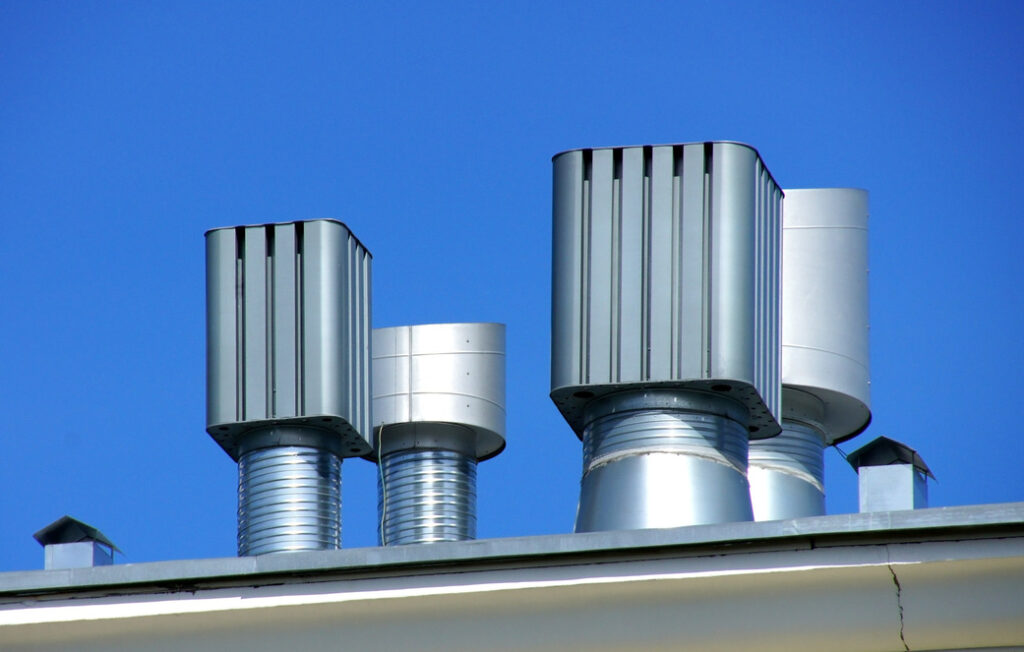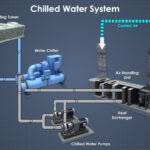HVAC stands for Heating, Ventilation, and Air Conditioning. The objective of HVAC is to control the temperature of air inside the designated “Air Conditioned” space along with control of moisture, filtration of air and containment of air borne particles, supply of outside fresh air for control of oxygen and carbon dioxide levels in the air conditioned space, and finally control of the movement of air or draught. Ventilation is the process or changing the air or replacing the air of any space by outside air as well as the circulation of the air between spaces for the basic purpose of maintaining the air quality. It removes the moisture, odors, bacteria, smoke, air-borne particles, etc. The ventilation of the space is an important process in maintaining the air quality indoors. As per ASHRAE standard 62 ventilation should be done for acceptable Indoor Air Quality (IAQ) standard. The purpose of ASHRAE standard 62 is to specify minimum ventilation rates and indoor air quality that will be acceptable to human occupants and are intended to minimize the potential of adverse health effects. The World Health Organization estimates that 30 % of all buildings suffer from Sick Building Syndrome due to improper indoor air quality and improper ventilation and air treatment.
Types of Ventilation
The acceptable air quality has to be maintained by supplying adequate air of specified quality and quantity in the space. The ventilation of the building can be done by natural ventilation by means of windows and skylights or by mechanical ventilation.
Natural ventilation is the ventilation of a building without the aid of fans or other mechanical systems. Historically all buildings were ventilated naturally with the help of windows and skylights. Natural ventilation use the pressure difference or temperature difference to allow the flow of air through the building. Natural ventilation is not very effective as humidity control is not proper, but when used in conjunction with mechanical systems they can save electricity.
Mechanical ventilation is also called forced or induced ventilation and is done by fans and other mechanical means. This means of ventilation is very effective in controlling the humidity and air quality inside an air conditioned space. As it is a positive means of ventilation it can control the odors, contaminants and humidity as well. There are many examples of mechanical ventilation like our kitchens and bathrooms that have exhaust fans.
Naturally Ventilated Building and Ducts for Mechanical Ventilation


Mechanical Ventilation
Mechanical ventilation is a method of forced or induced ventilation by using mechanical air handling systems, commonly called HVAC systems. Mechanical ventilation is more controllable than natural ventilation.
In Mechanical Ventilation blowers, fans, filters, and ducts are used for transporting and removing air from a space. There are two types of fans used for the transmission of air. When the air enters the impellers axially and is discharged radially from the impeller, it is called a centrifugal or radial flow fan. When the air flows parallel to the axis of impeller, it is called an axial flow fan.
Centrifugal Fan: Centrifugal fans are very popular in the duct air conditioning system. The centrifugal fan has an impeller mounted in a volute casing. The fan impeller of the centrifugal fan can have the following profiles:
· Radial or straight blades: It is a simple impeller construction. The blades run straight from a central point. These fans provide very high pressure at high speeds of rotation.
· Forward Curved Blades: These blades are shallow in depth. These fans are efficient and have less noise.
· Backward curved blades: They have to be operated at higher speeds for same pressure. Due to their higher speeds they can be directly coupled to the motors.
Axial Flow Fan: These fans are never used in duct air conditioning system as they cannot develop high pressures, however they can handle large quantities of air. The axial flow fans are of the following types:
· Propeller Fan: A propeller fan consist of a propeller in a mounting ring. They are used when the resistance to air movement is small as in the ventilation of bathrooms, and attic spaces.
· Tube Axial Fan: It consists of a propeller fan housed in a simple cylinder. These types of fans can be installed in round ducts. The air flow in the tube is spiral on its way out.
Vane Axial Fan: A vane axial fan has a tube axial fan along with guide vanes to stop the spiral movement of air.
Images

Air Changes Required
ASHRAE standard 62 states that certain amount of fresh air should always be supplied to all the areas of the building or the air conditioned spaces, which is dependent on the activity being done and the number of people present. For example dancing floors and smoking areas will require more air changes than other areas.
The air changes required by various spaces are as follows:
Bathroom and toilets: 3-8
Offices: 4-6
Meeting Rooms: 7-10
Restaurants: 8-12
Public Toilets: 10-15


